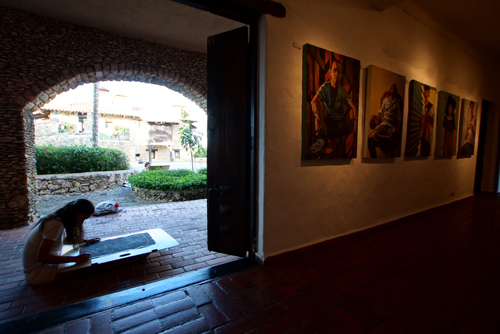We hired a car in Santo Domingo and drove ninety minutes east to the Hotel Vecchia Caserma, not far from La Romano.
This is the third largest town in the Dominican Republic and the area surrounding it has recently become a big tourist destination. Cruise ships can dock in the Romano River and there is the added incentive of an international airport.
And there’s golf.
Just outside of La Romana is Casa de Campo, a mega resort of 7,000 acres, built on land formally occupied by a sugar plantation.
There are three championship golf courses on the estate which is surrounded by luxury villas, condominiums and resort hotels.
On the eastern side and overlooking the Chavón River Gorge is Altos de Chavón.
Inspired by medieval Europe and built by Hollywood, this replica Mediterranean village is a tourist attraction, that also houses a museum and art colony.
Roberto Copa, a former set designer had the idea and his friend, Charles Bluhdorn the chairman of Paramount Pictures, funded his dream.
This complex is like Montsalvat on steroids.
Construction started in 1976, using stone from a local road building project, and was completed in the 1980s.
It sounds rather kitsch but in fact it’s a very pleasant place to visit.
The 15th century Italian style village is a great stage for the numerous restaurants, bars and boutiques. However it’s also a great cultural experience.
The compact, but well curated museum, covers the periods from 4,000 BC to 1492, the year Columbus arrived. While the art school and galleries are part of the Altos de Chavón Foundation that give local Caribbean artists an opportunity to further their studies abroad.
There’s even a Roman styled, 5,000 seat amphitheater where such diverse artists as Frank Sinatra and The Pet Shop Boys have performed.
As the light faded in the late afternoon we went to see the beach used by the ‘Day Trippers’
That night at dinner there was a large table of ‘God Botherers’ sitting near us. They were so close, and so loud, that we couldn’t help but be engulfed in the sermon that the group were subjected to, once they had all eaten their fill from the buffet.
It was full of platitudes and jargon about the subject of ‘grace’, none of which made sense to me.
It brought to mind the Stephen Fry rant about what sort of god would create a world that is so unjust.
I must agree with Stephen, where is the grace in a god that allows so much suffering and poverty.
The group were 15 American missionaries that seemed very pleased with themselves and the work they were doing, in the name of god.
They were here to help build a new church. I would have thought that a school would have been of more value.
Education rather than indoctrination.
I couldn’t help but think that the Conquistadors and the Catholic Clergy that followed Columbus in 1492 had the same religious zeal. And look how they devastated entire ancient societies in the New World – and all in the name of god.
The next day we decided to drive around the eastern part of the Island.
Our first stop was Bayahibe, a small fishing village and resort east of La Romana.
That was the last real village we got to see for many hours.
As we drove east to Punta Cana and then north along the coast to towards El Cedro there was nothing but resorts, all with boom gates and heavy security.
The entire coast has been taken over by private enterprise, only catering to the packaged tourists.
We had heard that many of the roads were poor – our experience was very different. The ones we used were in excellent condition, however the road signs were quite ambiguous.
It was only after we headed south, over the mountains near El Seibo, that conditions got a little hairy. This had nothing to do with the roads, but rather the many landslides that had recently occurred as a result of the heavy rain.
The only other road hazard was the numerous speed humps that stood sentry on either side of every village and at most intersections.
These speed traps varied in height from a mere bump in the road to something resembling a rallycross circuit.
At one point we were stuck behind a fully laden pick-up truck who struggle to get over the hump.
Some of these obstacles were painted yellow, so you could see them coming, however the vast majority we unmarked and therefore unexpected.
The Kia’s suspension took a pounding.
It was a great road trip, my only regret being that I couldn’t get any snaps along the way.
The roads were windy, with cavernous drains on either side and all marked with double lines, making stopping impossible.
On our last day we headed out in the car again. This time we did a loop, travelling north and west, via Hato Mayor and then down into La Romana.
This is a large town, by Dominican standards, but not really set up for tourists. They come in and are immediately whisked away to the resorts. These are self contained enclaves that don’t really encourage their patrons venturing off the resort grounds.











